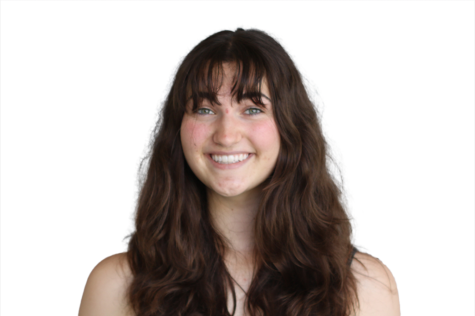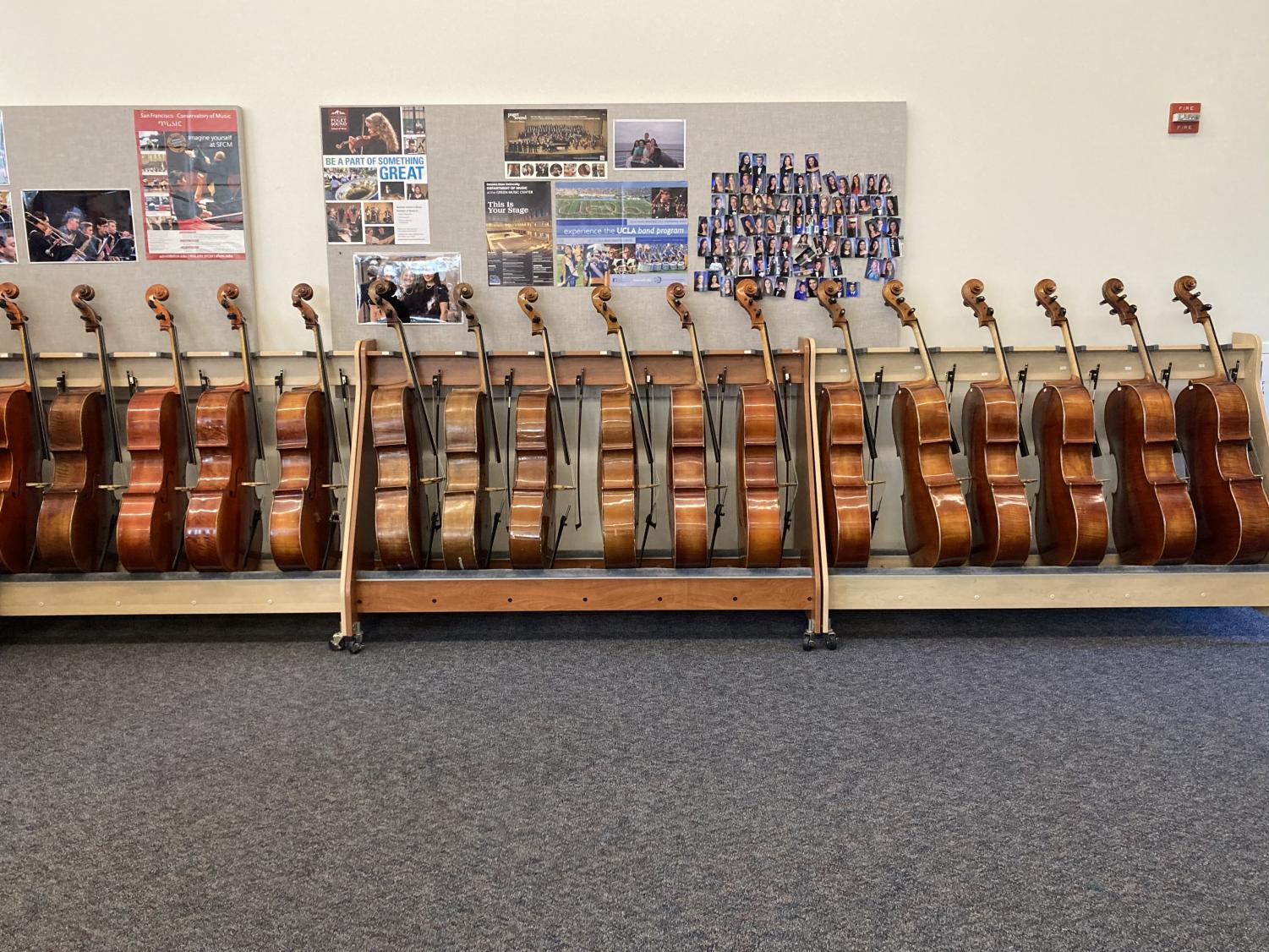
Twitter: @ChesneyEvert
Instagram: @chest_knee


March 16, 2021
As the Sequoia Union High School District (SUHSD) approaches its return to in-person learning, chairs, tables, and bathrooms previously untouched are reintegrating into daily use. However, some school resources remain stowed away, awaiting normalcy.
Among them is the Carlmont music department’s Steinway grand piano.
Since the Carlmont choir’s last concert on March 6, 2020, the Steinway piano has stayed in the Performing Arts Center’s (PAC) orchestra pit, under the stage, tucked away from reality.
Although this might seem like an ideal location, Genevieve Tep, Carlmont’s choir director, expressed concerns for the piano’s safety in January 2021.
“We’ve always had the issue of when no one’s there, they don’t heat or cool the building,” Tep said. “So, when the campus has been shut down for weeks on end, the wood instruments could be exposed to temperature fluctuations and changes in humidity.”
According to the Hollywood Piano Company, owners should keep pianos between 50 and 70 degrees Fahrenheit in 40-45% humidity for optimal performance. However, in Belmont, temperatures can rise above 80 degrees Fahrenheit in the summer months with an average of 80.2% humidity, as stated by the National Ocean and Atmospheric Administration. A climate outside of the recommended range can impact a piano’s tuning and construction, with prolonged exposure resulting in severe consequences.
“Things like changes in temperature and humidity can cause corrosion in the strings, which will have a lasting effect on an instrument. Also, as wood swells and contracts, it can lose its shape,” said Michael Kimbell, a local piano repair technician.
Kimbell and his wife, Edith, have worked in piano service and music composition in the Bay Area since 1979, after leaving music teaching jobs. Having worked on pianos at institutions like the San Francisco Conservatory of Music, as well as in people’s homes, he is no stranger to the nuances of piano care.
“Worst case scenario, the piano’s joints may have stiffened severely,” Kimbell said. “A technician may have to repin and realign all 88 joints, which is extremely tedious.”
Were Carlmont’s piano to endure harmful temperatures in the PAC, the music department would have to weigh the cost of preventative maintenance versus repair expenses, finding a solution that serves best interests of the department and district budget.
Through thick and thin, SUHSD’s Maintenance and Operations Department keeps its campuses running, with the allocated district budget for the 2020-21 school year.
This budget contains funding for campus construction and repairs, renting equipment, and communication needs, among many other operational facets. Specifically, the First Interim Report has set aside $52,511 for operating and housekeeping expenses such as the use of heating, ventilation, and air conditioning (HVAC) systems. If a need arises, campus administration can fill out a work order, a document that addresses a problem and provides a plan to fix it.
“A work order has to be put in by the plant manager, and then it gets sent to Walter Haub, the director of MnO [Matinence and Operations],” said Dina Stewart, SUHSD’s financial controller.
As the financial controller, Stewart’s job is to manage the district’s accounting and oversee budget preparation. She detailed that once a work order is submitted, it is up to the Maintenance and Operations department to assess where those costs go.
“You have an actual school budget, within Carlmont, which is for whatever maintenance you want to do,” Stewart said. “If it is something out of the norm, then you can tap into other facilities budgets depending on the amount and specific program it’s for, which is decided by MnO.”
Whether Carlmont’s administration uses budgeted funds to heat and cool the piano’s location during distance learning or repair possible damage it may have experienced, they would use a work order to propose expenditures.
Despite the option of submitting a work order, Stewart recommended against using HVAC to protect the piano.
“Just knowing history, anytime you deal with HVAC, it’s always very costly, and it’s probably a lot cheaper to do repairs as needed,” Stewart said.
In addition to potentially exorbitant costs, Grant Stuenenberg, Carlmont’s administrative vice principal, shared concern over the environmental impact that using HVAC systems would entail.
“The PAC is a huge building, and heating it and cooling it when no one is there could waste a lot of energy,” Steunenberg said. “It’s a lot easier to do [temperature control] for instruments in the F-wing, as it’s a smaller, more contained area.”
In February 2021, Stuenenberg and Tep were working to find a sustainable solution. One proposal was to move the Steinway piano into the F-wing, where Carlmont’s band, choir, and art classrooms are located, which also house the other instruments at safe temperatures.
“Mrs. Tep has gotten some advice from people in the business about what to do when storing an instrument as valuable as the Steinway. Since we have other instruments on campus already, it makes sense to consolidate them in one area. However, logistically, moving the piano could be challenging,” Stuenenberg said.
According to Yamaha Corporation, the instrument was created in 1700s Italy by Bartolomeo Cristofori. The modern piano has a wooden body that envelops about 230 strings and 88 felt-covered hammers, which each connects to a corresponding key. When a key is pressed, the hammers hit the strings to produce notes. It is imperative that the strings remain in tune and the structure remains intact to make sure each key can accurately hit the correct note, to produce the best music.

On average, a Steinway Grand Piano costs around $100,000, depending on the size and model. Similar to a car, it requires maintenance which varies based on how frequently it’s in use.
At a minimum, Amro Music recommends tuning a piano about once a year. However, Kimbell recognizes that environmental factors can impact the cost and extensivity of needed maintenance.
“Best case scenario, a piano left without heating or cooling for a year will need a double tuning and joint lubrication, which will likely cost around $300,” Kimbell said. “If the joints need repinning in addition to those other services, it could be over $1,000.”
To prevent those extra costs in areas with intense temperature fluctuations, additional protection can be supplemented without modifying the climate.
“There are systems that you can install under the piano, like the Dampp Chaser, which uses dehumidifier rods to dry out the air surrounding the piano. There’s also a humidifier that can be used if the air gets too dry,” Kimbell said.
A Piano Life Saver system combines these two pieces of technology, requiring professional installation by a piano technician and costing between $400-$800, depending on the piano’s size.
Although the cost of maintaining a piano may seem overbearing, especially to a school with other maintenance priorities, Kimbell believes that it’s worth having a fully-functional instrument.
“You have to weigh the pros and cons of where you want to spend your money,” Kimbell said. “For me, the beauty and complexity of music are more important than the cost.”
On March 10, 2021, Steunenberg confirmed that the Steinway piano is being kept at a safe temperature after a conversation with Carlmont’s theater manager, Geoffrey Horn.
“Mr. Horn said the median temperature maintained in the PAC allows for safe storage of the instrument and that the piano is actually ready to receive its bi-annual tuning and maintenance, which he is in the process of scheduling,” Steunenberg said.
Had there been a time when the piano was exposed to an inappropriate climate, the Carlmont administration could have taken various steps towards fixing the problem, whether through completing a work order, purchasing piano care equipment, or repairing damage when necessary.
“When this problem was initially brought to our attention, we explored several options in hopes of doing what was best for the school,” Steunenberg said. “Although we aren’t always on the same page, everyone involved wants to do the right thing, and in the end, we tend to figure it out.”
